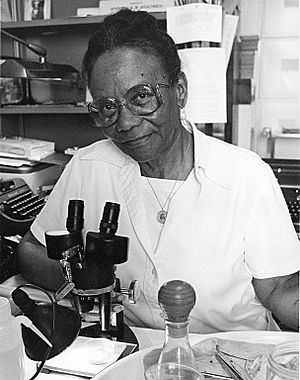Sophie Lutterlough facts for kids
Quick facts for kids
Sophie Lutterlough
|
|
|---|---|

Sophie Lutterlough in 1983 at the Smithsonian
|
|
| Born |
Sophie G. Mack
1910 |
| Died | February 11, 2009 (aged 98) |
| Nationality | American |
| Occupation |
|
| Known for |
|
Sophie Lutterlough (1910–2009) was an amazing American scientist who studied insects. She was an entomologist. Sophie started working at the Smithsonian National Museum of Natural History (NMNH) in the 1940s. At that time, it was hard for African-Americans to get science jobs at the museum.
She began as an elevator operator. But Sophie learned a lot about the museum's exhibits. In the late 1950s, she asked for a job working with insects. She became very good at it. Sophie helped restore hundreds of thousands of insects. She also classified thousands of them. A tiny mite was even named after her in 1979.
Early Life and School
Sophie Lutterlough was born Sophie G. Mack. She was born in Washington, D.C.. Sophie had two sisters and one brother.
She went to Dunbar High School. She graduated in 1928. Sophie took biology classes there. She was one of the best students in her class.
Her Career at the Museum
In 1943, Sophie Lutterlough applied for a job. She wanted to work at the Smithsonian National Museum of Natural History (NMNH). Because of racial barriers, she could not get a direct science job.
She was hired as an elevator operator. She was the first woman to have this job at the Smithsonian. Sophie worked in this role for 14 years. During her lunch breaks, she studied the museum's exhibits. She became very knowledgeable. Visitors often asked her questions.
Many people became scientists at the NMNH through training. They did not always have a science degree. Sophie started this path in 1957. She asked J.F. Gates Clark, an insect curator, if she could work in his department. She got a job as an insect preparator.
Sophie worked on identifying the museum's insect collection. Within two years, she became a research assistant. For the next 24 years, she worked on many arthropods. These included centipedes and millipedes. She also worked on ticks and other species. For example, in 1963-1964, she restored over 300,000 ticks.
Sophie took college classes in science and writing. She also studied German. This helped her grow as an entomologist. She restored 35,000 ticks. This work helped her and her supervisor, Dr. Ralph Crabill, identify 40 type specimens. A type specimen is a main example for a species. Sophie retired from the NMNH after 40 years of work.
Her Personal Life
In 1941, Sophie married Henry E. Lutterlough. Henry worked in a biochemistry lab. It was at the National Institutes of Health.
Sophie later became a widow. In 1999, she moved to New Jersey. She lived with her daughter in Monroe Township, Middlesex County, New Jersey. Sophie was a member of the People's Congregational Church since 1960. She was the first soprano in its choir. When she moved to New Jersey, she joined the Cross of Glory Lutheran Church and its choir. Sophie Lutterlough passed away in Monroe Township on February 11, 2009. She was 98 years old.
Awards and Recognition
In 1979, a special honor was given to Sophie. A mite from the genus Pygmephorus was named after her. This mite is called Pygmephorus lutterloughae. It is a large mite. It was found in Oregon in 1970. The sample was in the NMNH collection.
When she retired from the Smithsonian in 1983, Sophie Lutterlough received an award. It was called the Exemplary Service award.

